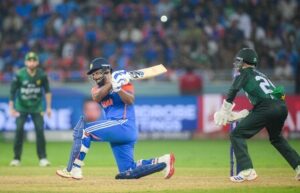What Makes a Cricket Ball Swing? A Recent Study By IITKanpur Finds Out
Kanpur : Cricket these days is becoming more and more a batsman’s game or so people claim, based on the fact that more runs are scored these days than a decade back.
To bring the game to a more level playing field for bowlers and to make it more competitive and exciting for viewers, researchers at IIT Kanpur have conducted experiments to understand the physics governing the swing of a cricket ball.
With the findings of the study, it is better understood what role factors such as angle of the seam of the ball, its speed, the roughness of its surface and the weather conditions play in the swing achieved with a ball. This research has been accepted for publication in the prestigious Journal of Fluid Mechanics.
The research was carried out by Professor Sanjay Mittal, Department of Aerospace Engineering along with Rahul Deshpande and Ravi Shakya at the National Wind Tunnel Facility at IIT Kanpur. Professor Mittal’s research group also utilizes computational modeling to complement the findings from experimental studies.
They found that contrary to what is popularly believed by both sportspersons and viewers, a reverse swing can be achieved in a cricket ball even when it is new. They found that when the seam of the ball is oriented at 20 degrees to its direction of movement, the ball undergoes conventional swing for speeds between 30-119 Kmph.
Professor Mittal said that it undergoes reverse swing for speeds in excess of 125 Kmph. If the ball is delivered between a speed of 119-125 Kmph, it undergoes reverse swing for the initial part of its trajectory and then experiences conventional swing. This also explains what is often referred to as late-swing. All of these speeds, though, depend on the weather conditions.
The team also experimented with manually roughened cricket balls to study the effect of surface roughness on their swing properties. They found that a roughened ball swings at a much lower speed as compared to a new ball.
Professor Mittal said that the conventional swing is observed for speeds between 20-70 Kmph, while reverse swing occurs for speeds between 79-140 Kmph. He said that this meant that for skilled medium pacers, an older ball will be better for throwing off the batsman, as compared to a new ball.
Experiments were also also conducted on a ball wherein one half of the ball is roughened while the other is ‘shiny’. This technique is often utilized by the bowling side. In certain conditions such a ball can reverse swing for speeds as low as 35 Kmph At speeds higher than 90kmph, the ball exhibits conventional swing.
Based on the knowledge obtained from this study, Professor Mittal said that the team is working towards implementing basic changes to the current cricket ball to propose a unique design which can make the sport much more competitive and unpredictable for batsmen. One possible alteration can be the slight reduction of the thickness of the seam from the current 1 mm – which can influence the swing properties of the ball significantly.
With the debate around the new ‘pink’ balls introduced in the recent day-night Test matches, this study can conclusively help understand how different balls under different conditions can make or break a team’s game.
The team is also investigating the ‘knuckle-ball’ trajectory which is relatively unexplained.
Published on: July 10, 2018 at 10:39 IST
By EP Web Desk







